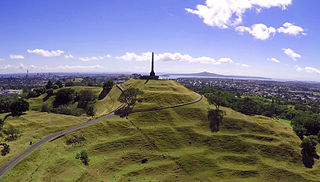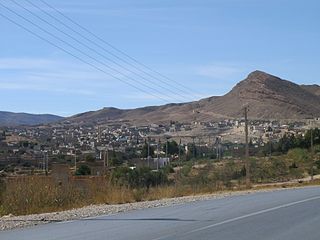
The Sahara is a desert on the African continent. With an area of 9,200,000 square kilometres (3,600,000 sq mi), it is the largest hot desert in the world and the third-largest desert overall, smaller only than the deserts of Antarctica and the northern Arctic.

Australian Light Horse were mounted troops with characteristics of both cavalry and mounted infantry, who served in the Second Boer War and World War I. During the inter-war years, a number of regiments were raised as part of Australia's part-time military force. These units were gradually mechanised either before or during World War II, although only a small number undertook operational service during the war. A number of Australian light horse units are still in existence today.

The military history of New Zealand during World War II began when New Zealand entered the Second World War by declaring war on Nazi Germany with the United Kingdom. New Zealand's forces were soon serving across Europe and beyond, where their reputation was generally very good. In particular, the force of the New Zealanders who stationed in Northern Africa and Southern Europe was known for its strength and determination, and uniquely so on both sides.

Maungakiekie / One Tree Hill is a 182-metre (597 ft) volcanic peak and Tūpuna Maunga in Auckland, New Zealand. It is an important place culturally and archeologically for both Māori and Pākehā. The suburb around the base of the hill is also called One Tree Hill. It is surrounded by the suburbs of Royal Oak to the west, and clockwise, Epsom, Greenlane, Oranga, and Onehunga. The summit provides views across the Auckland area, and allows visitors to see both of Auckland's harbours.

Campbell Island / Motu Ihupuku is an uninhabited subantarctic island of New Zealand, and the main island of the Campbell Island group. It covers 112.68 square kilometres (43.51 sq mi) of the group's 113.31 km2 (43.75 sq mi), and is surrounded by numerous stacks, rocks and islets like Dent Island, Folly Island, Isle de Jeanette-Marie, and Jacquemart Island, the latter being the southernmost extremity of New Zealand. The island is mountainous, rising to over 500 metres (1,640 ft) in the south. A long fiord, Perseverance Harbour, nearly bisects it, opening out to sea on the east coast.

Biskra is the capital city of Biskra Province, Algeria. In 2007, its population was recorded as 307,987. Biskra is located in northeastern Algeria, about 248 miles (399 km) from Algiers, 71 miles (114 km) southwest of Batna and 137 miles (220 km) north of Touggourt. It is nicknamed "The Queen of the Zibans", "The Door of the Desert" or "The Saharan Nice" because of its location at the beginning of the Sahara Desert. Due to its geographical location, its climate and natural resources, particularly farming, Biskra has always been a crossroad between the cities in the north and south. It has seen the passage of several civilizations, from the Romans and the Arabs to the French.

Saada, a city and ancient capital in the northwest of Yemen, is the capital and largest city of the province of the same name, and the county seat of the county of the same name. The city is located in the mountains of Serat (Sarawat) at an altitude of about 1,800 meters and had an estimated population of 51,870 in 2004, when it was the tenth largest city in Yemen.

Bou Saada is a town and municipality in M'Sila Province, Algeria, situated 245 km south of Algiers. As Arena it was the site of a city and bishopric in Roman Africa, now a Catholic titular see. The municipal population was estimated at 134,000 in 2008.

M'Sila is a province (wilaya) of northern Algeria. It has a population of 1 million people and an area of 18,718 km², while its capital, also called M'Sila, home to M'Sila University, has a population of about 100,000.
Bou Saada Airport, also known as Ain Eddis Airport, is an airport located 7.5 NM north of Bou Saada, Algeria.

The 2nd Light Horse Brigade was a mounted infantry brigade of the Australian Imperial Force (AIF) which served in the Middle Eastern theatre of World War I. The brigade was initially formed as a part-time militia formation in the early 1900s in New South Wales. In 1914, the brigade was re-constituted as part of the AIF. The brigade first saw action while serving in the Australian and New Zealand Army Corps (ANZAC) during the Gallipoli campaign. After being withdrawn to Egypt in February 1916 they served in the ANZAC Mounted Division from March 1916 as part of the Egyptian Expeditionary Force during the Sinai and Palestine Campaign until the end of the war. After the war, the AIF light horse regiments were demobilised and disbanded; however, the brigade briefly existed as a part-time militia formation in New South Wales until 1921 when its regiments were reorganised into cavalry brigades.

The 5th Light Horse Brigade was a mounted infantry brigade of the First Australian Imperial Force (AIF) that served during World War I. The brigade was initially formed as a part-time militia formation in the early 1900s in Queensland. During World War I, the brigade was formed in Palestine in July 1918 following the disbandment of the Imperial Camel Corps. At this time, the brigade consisted of two Australian Light Horse regiments and a French cavalry regiment, and was supported by British and New Zealand artillery and machine gun troops. It served in the Middle Eastern theatre of World War I in the Sinai and Palestine Campaign as part of the Australian Mounted Division, but only saw limited operations before the war ended, taking part in the capture of Damascus in September and October 1918. After the war, the AIF light horse regiments were demobilised and disbanded; however, the brigade briefly existed as a part-time militia formation in Victoria until 1921 when its regiments were reorganised into cavalry brigades.

El Hamel is a town and commune in M'Sila Province, Algeria. According to the 1998 census it has a population of 10,195.
Hocine El Orfi is an Algerian footballer. He plays mainly as a defensive midfielder.
Jacqueline Nancy Mary Adams was a New Zealand botanical illustrator and museum curator.

Gustave Achille Guillaumet was a French artist. He is best known for his paintings of North Africa.

The Ouled Naïl are an Arab tribal confederation living in the Ouled Naïl Range, Algeria. They are found mainly in Bou Saâda, M'Sila and Djelfa, but there is also a significant number of them in Ghardaïa.
The 2013–14 Algerian Ligue Professionnelle 2 was the forty-eight edition of the Algerian second division since its establishment, and its fourth season of the league under its current title. A total of 16 teams contested the league. The league started August 23, 2013, and concluded on May 16, 2014. USM Bel-Abbès were crowned champions and promoted to the 2014–15 Algerian Ligue Professionnelle 1 along with NA Hussein Dey and ASM Oran. At the bottom of the table, A Bou Saâda, US Chaouia and USMM Hadjout were relegated.
The 2013–14 Algerian Cup was the 50th edition of the Algerian Cup. The winners were MC Alger who qualified for the 2015 CAF Confederation Cup.

La Route impériale is a 1935 French film directed by Marcel L'Herbier. It combines a romantic drama with a military adventure story, set against the contemporary background of British operations against a rebellion in the kingdom of Iraq.














